List of uniform polyhedra
In geometry, a uniform polyhedron is a polyhedron which has regular polygons as faces and is vertex-transitive (transitive on its vertices, isogonal, i.e. there is an isometry mapping any vertex onto any other). It follows that all vertices are congruent, and the polyhedron has a high degree of reflectional and rotational symmetry.
Uniform polyhedra can be divided between convex forms with convex regular polygon faces and star forms. Star forms have either regular star polygon faces or vertex figures or both.
This list includes these:
- all 75 nonprismatic uniform polyhedra;
- a few representatives of the infinite sets of prisms and antiprisms;
- one degenerate polyhedron, Skilling's figure with overlapping edges.
It was proven in Sopov (1970) that there are only 75 uniform polyhedra other than the infinite families of prisms and antiprisms. John Skilling discovered an overlooked degenerate example, by relaxing the condition that only two faces may meet at an edge. This is a degenerate uniform polyhedron rather than a uniform polyhedron, because some pairs of edges coincide.
Not included are:
- 40 potential uniform polyhedra with degenerate vertex figures which have overlapping edges (not counted by Coxeter);
- The uniform tilings (infinite polyhedra)
- 11 Euclidean uniform tessellations with convex faces;
- 14 Euclidean uniform tilings with nonconvex faces;
- Infinite number of uniform tilings in hyperbolic plane.
- Any polygons or 4-polytopes
Indexing
Four numbering schemes for the uniform polyhedra are in common use, distinguished by letters:
- [C] Coxeter et al., 1954, showed the convex forms as figures 15 through 32; three prismatic forms, figures 33–35; and the nonconvex forms, figures 36–92.
- [W] Wenninger, 1974, has 119 figures: 1-5 for the Platonic solids, 6-18 for the Archimedean solids, 19-66 for stellated forms including the 4 regular nonconvex polyhedra, and ended with 67-119 for the nonconvex uniform polyhedra.
- [K] Kaleido, 1993: The 80 figures were grouped by symmetry: 1-5 as representatives of the infinite families of prismatic forms with dihedral symmetry, 6-9 with tetrahedral symmetry, 10-26 with Octahedral symmetry, 46-80 with icosahedral symmetry.
- [U] Mathematica, 1993, follows the Kaleido series with the 5 prismatic forms moved to last, so that the nonprismatic forms become 1–75.
Names of polyhedra by number of sides
The generic geometric names for the most common polyhedra. The 5 regular polyhedra are called a tetrahedron, hexahedron, octahedron, dodecahedron and icosahedron with 4, 6, 8, 12, and 20 sides respectively.
Table of polyhedra
The convex forms are listed in order of degree of vertex configurations from 3 faces/vertex and up, and in increasing sides per face. This ordering allows topological similarities to be shown.
Convex uniform polyhedra
| Name | Picture | Vertex type | Wythoff symbol | Sym. | C# | W# | U# | K# | Vert. | Edges | Faces | Faces by type |
|---|---|---|---|---|---|---|---|---|---|---|---|---|
| Tetrahedron | 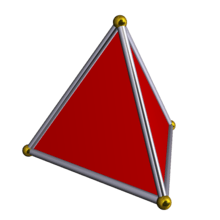 |  3.3.3 | 3 | 2 3 | Td | C15 | W001 | U01 | K06 | 4 | 6 | 4 | 4{3} |
| Triangular prism |  |  3.4.4 | 2 3 | 2 | D3h | C33a | -- | U76a | K01a | 6 | 9 | 5 | 2{3} +3{4} |
| Truncated tetrahedron |  | 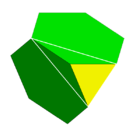 3.6.6 | 2 3 | 3 | Td | C16 | W006 | U02 | K07 | 12 | 18 | 8 | 4{3} +4{6} |
| Truncated cube | 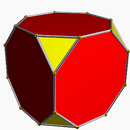 |  3.8.8 | 2 3 | 4 | Oh | C21 | W008 | U09 | K14 | 24 | 36 | 14 | 8{3} +6{8} |
| Truncated dodecahedron | 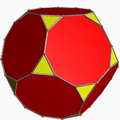 |  3.10.10 | 2 3 | 5 | Ih | C29 | W010 | U26 | K31 | 60 | 90 | 32 | 20{3} +12{10} |
| Cube |  |  4.4.4 | 3 | 2 4 | Oh | C18 | W003 | U06 | K11 | 8 | 12 | 6 | 6{4} |
| Pentagonal prism | 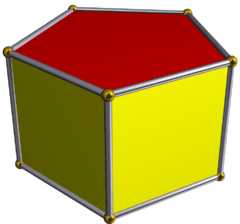 |  4.4.5 | 2 5 | 2 | D5h | C33b | -- | U76b | K01b | 10 | 15 | 7 | 5{4} +2{5} |
| Hexagonal prism |  |  4.4.6 | 2 6 | 2 | D6h | C33c | -- | U76c | K01c | 12 | 18 | 8 | 6{4} +2{6} |
| Octagonal prism | 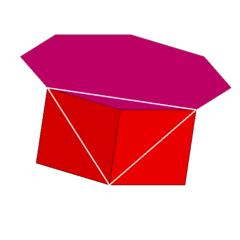 4.4.8 | 2 8 | 2 | D8h | C33e | -- | U76e | K01e | 16 | 24 | 10 | 8{4} +2{8} | |
| Decagonal prism | 4.4.10 | 2 10 | 2 | D10h | C33g | -- | U76g | K01g | 20 | 30 | 12 | 10{4} +2{10} | |
| Dodecagonal prism | 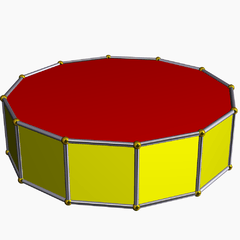 | 4.4.12 | 2 12 | 2 | D12h | C33i | -- | U76i | K01i | 24 | 36 | 14 | 12{4} +2{12} |
| Truncated octahedron | 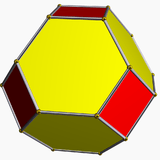 | 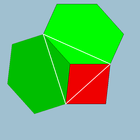 4.6.6 | 2 4 | 3 | Oh | C20 | W007 | U08 | K13 | 24 | 36 | 14 | 6{4} +8{6} |
| Truncated cuboctahedron |  |  4.6.8 | 2 3 4 | | Oh | C23 | W015 | U11 | K16 | 48 | 72 | 26 | 12{4} +8{6} +6{8} |
| Truncated icosidodecahedron | 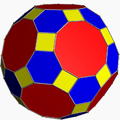 |  4.6.10 | 2 3 5 | | Ih | C31 | W016 | U28 | K33 | 120 | 180 | 62 | 30{4} +20{6} +12{10} |
| Dodecahedron | 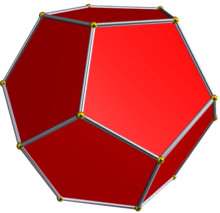 | 5.5.5 | 3 | 2 5 | Ih | C26 | W005 | U23 | K28 | 20 | 30 | 12 | 12{5} |
| Truncated icosahedron | 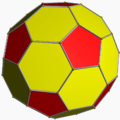 |  5.6.6 | 2 5 | 3 | Ih | C27 | W009 | U25 | K30 | 60 | 90 | 32 | 12{5} +20{6} |
| Octahedron | 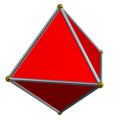 | 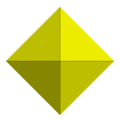 3.3.3.3 | 4 | 2 3 | Oh | C17 | W002 | U05 | K10 | 6 | 12 | 8 | 8{3} |
| Square antiprism |  | 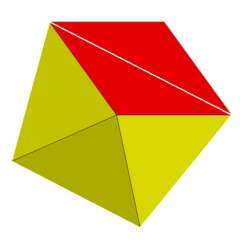 3.3.3.4 | | 2 2 4 | D4d | C34a | -- | U77a | K02a | 8 | 16 | 10 | 8{3} +2{4} |
| Pentagonal antiprism | 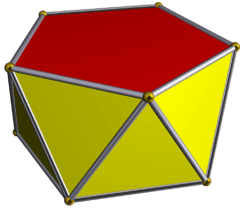 |  3.3.3.5 | | 2 2 5 | D5d | C34b | -- | U77b | K02b | 10 | 20 | 12 | 10{3} +2{5} |
| Hexagonal antiprism | 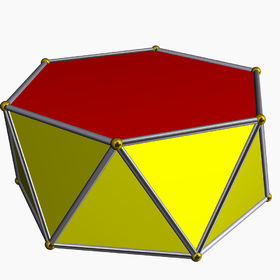 |  3.3.3.6 | | 2 2 6 | D6d | C34c | -- | U77c | K02c | 12 | 24 | 14 | 12{3} +2{6} |
| Octagonal antiprism | 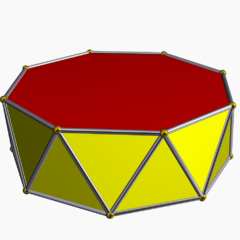 | 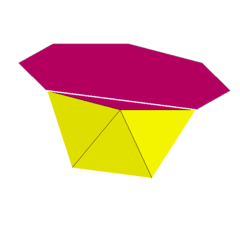 3.3.3.8 | | 2 2 8 | D8d | C34e | -- | U77e | K02e | 16 | 32 | 18 | 16{3} +2{8} |
| Decagonal antiprism |  | 3.3.3.10 | | 2 2 10 | D10d | C34g | -- | U77g | K02g | 20 | 40 | 22 | 20{3} +2{10} |
| Dodecagonal antiprism |  | 3.3.3.12 | | 2 2 12 | D12d | C34i | -- | U77i | K02i | 24 | 48 | 26 | 24{3} +2{12} |
| Cuboctahedron | 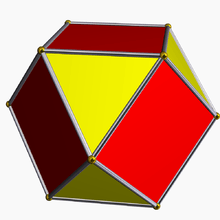 | 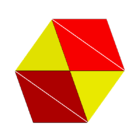 3.4.3.4 | 2 | 3 4 | Oh | C19 | W011 | U07 | K12 | 12 | 24 | 14 | 8{3} +6{4} |
| Rhombicuboctahedron | 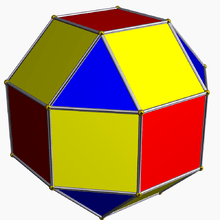 |  3.4.4.4 | 3 4 | 2 | Oh | C22 | W013 | U10 | K15 | 24 | 48 | 26 | 8{3} +(6+12){4} |
| Rhombicosidodecahedron | 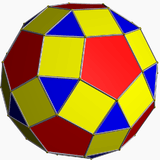 |  3.4.5.4 | 3 5 | 2 | Ih | C30 | W014 | U27 | K32 | 60 | 120 | 62 | 20{3} +30{4} +12{5} |
| Icosidodecahedron | 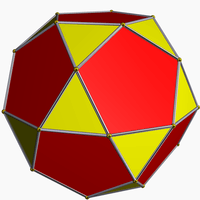 | 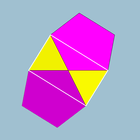 3.5.3.5 | 2 | 3 5 | Ih | C28 | W012 | U24 | K29 | 30 | 60 | 32 | 20{3} +12{5} |
| Icosahedron | 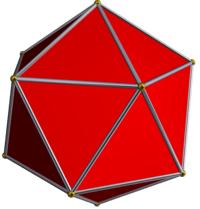 |  3.3.3.3.3 | 5 | 2 3 | Ih | C25 | W004 | U22 | K27 | 12 | 30 | 20 | 20{3} |
| Snub cube |  |  3.3.3.3.4 | | 2 3 4 | O | C24 | W017 | U12 | K17 | 24 | 60 | 38 | (8+24){3} +6{4} |
| Snub dodecahedron | 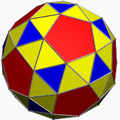 |  3.3.3.3.5 | | 2 3 5 | I | C32 | W018 | U29 | K34 | 60 | 150 | 92 | (20+60){3} +12{5} |
Uniform star polyhedra
| Name | Image | Wyth sym | Vert. fig | Sym. | C# | W# | U# | K# | Vert. | Edges | Faces | Chi | Orient able? | Dens. | Faces by type |
|---|---|---|---|---|---|---|---|---|---|---|---|---|---|---|---|
| Octahemioctahedron |  | 3/2 3 | 3 | 6.3/2.6.3 | Oh | C37 | W068 | U03 | K08 | 12 | 24 | 12 | 0 | Yes | 8{3}+4{6} | |
| Tetrahemihexahedron | 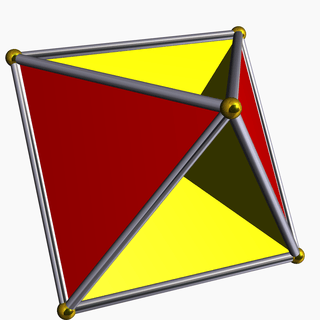 | 3/2 3 | 2 |  4.3/2.4.3 | Td | C36 | W067 | U04 | K09 | 6 | 12 | 7 | 1 | No | 4{3}+3{4} | |
| Cubohemioctahedron | 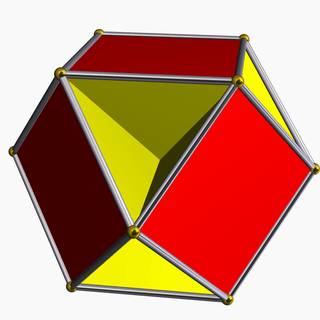 | 4/3 4 | 3 | 6.4/3.6.4 | Oh | C51 | W078 | U15 | K20 | 12 | 24 | 10 | -2 | No | 6{4}+4{6} | |
| Great dodecahedron |  | 5/2 | 2 5 |  (5.5.5.5.5)/2 | Ih | C44 | W021 | U35 | K40 | 12 | 30 | 12 | -6 | Yes | 3 | 12{5} |
| Great icosahedron | 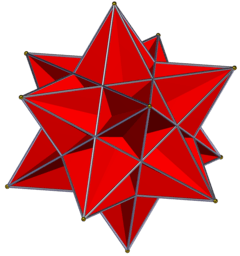 | 5/2 | 2 3 |  (3.3.3.3.3)/2 | Ih | C69 | W041 | U53 | K58 | 12 | 30 | 20 | 2 | Yes | 7 | 20{3} |
| Great ditrigonal icosidodecahedron | 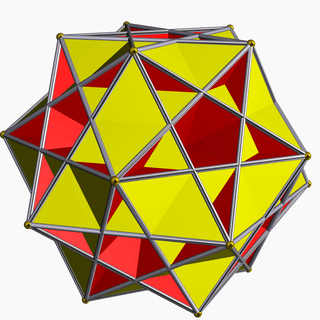 | 3/2 | 3 5 | (5.3.5.3.5.3)/2 | Ih | C61 | W087 | U47 | K52 | 20 | 60 | 32 | -8 | Yes | 6 | 20{3}+12{5} |
| Small rhombihexahedron | 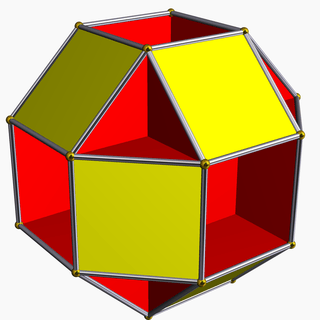 | 2 4 (3/2 4/2) | |  4.8.4/3.8/7 | Oh | C60 | W086 | U18 | K23 | 24 | 48 | 18 | -6 | No | 12{4}+6{8} | |
| Small cubicuboctahedron | 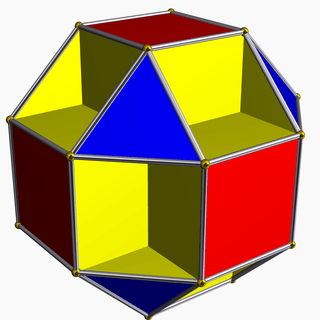 | 3/2 4 | 4 | 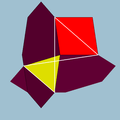 8.3/2.8.4 | Oh | C38 | W069 | U13 | K18 | 24 | 48 | 20 | -4 | Yes | 2 | 8{3}+6{4}+6{8} |
| Great rhombicuboctahedron | 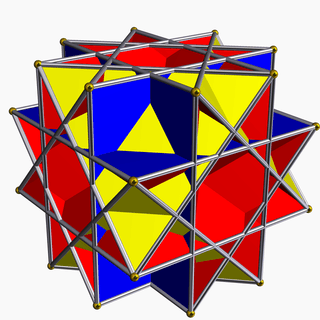 | 3/2 4 | 2 | 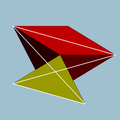 4.3/2.4.4 | Oh | C59 | W085 | U17 | K22 | 24 | 48 | 26 | 2 | Yes | 5 | 8{3}+(6+12){4} |
| Small dodecahemi- dodecahedron |  | 5/4 5 | 5 |  10.5/4.10.5 | Ih | C65 | W091 | U51 | K56 | 30 | 60 | 18 | -12 | No | 12{5}+6{10} | |
| Great dodecahem- icosahedron |  | 5/4 5 | 3 |  6.5/4.6.5 | Ih | C81 | W102 | U65 | K70 | 30 | 60 | 22 | -8 | No | 12{5}+10{6} | |
| Small icosihemi- dodecahedron | 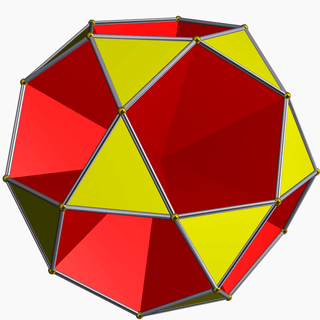 | 3/2 3 | 5 | 10.3/2.10.3 | Ih | C63 | W089 | U49 | K54 | 30 | 60 | 26 | -4 | No | 20{3}+6{10} | |
| Small dodecicosahedron | 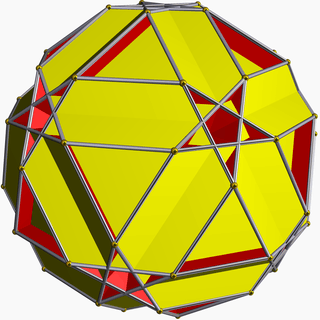 | 3 5 (3/2 5/4) | |  10.6.10/9.6/5 | Ih | C64 | W090 | U50 | K55 | 60 | 120 | 32 | -28 | No | 20{6}+12{10} | |
| Small rhombidodecahedron | 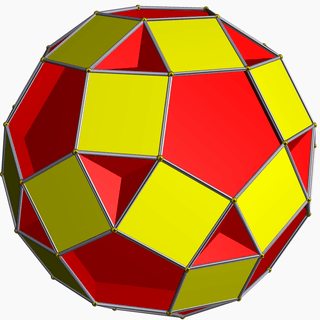 | 2 5 (3/2 5/2) | |  10.4.10/9.4/3 | Ih | C46 | W074 | U39 | K44 | 60 | 120 | 42 | -18 | No | 30{4}+12{10} | |
| Small dodecicosi- dodecahedron |  | 3/2 5 | 5 |  10.3/2.10.5 | Ih | C42 | W072 | U33 | K38 | 60 | 120 | 44 | -16 | Yes | 2 | 20{3}+12{5}+12{10} |
| Rhombicosahedron |  | 2 3 (5/4 5/2) | | 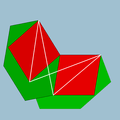 6.4.6/5.4/3 | Ih | C72 | W096 | U56 | K61 | 60 | 120 | 50 | -10 | No | 30{4}+20{6} | |
| Great icosicosi- dodecahedron | 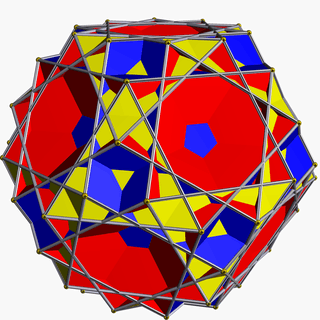 | 3/2 5 | 3 | 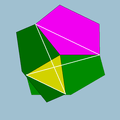 6.3/2.6.5 | Ih | C62 | W088 | U48 | K53 | 60 | 120 | 52 | -8 | Yes | 6 | 20{3}+12{5}+20{6} |
| Pentagrammic prism | 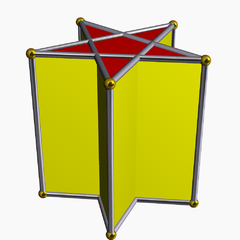 | 2 5/2 | 2 | 5/2.4.4 | D5h | C33b | -- | U78a | K03a | 10 | 15 | 7 | 2 | Yes | 2 | 5{4}+2{5/2} |
| Heptagrammic prism (7/2) |  | 2 7/2 | 2 |  7/2.4.4 | D7h | C33d | -- | U78b | K03b | 14 | 21 | 9 | 2 | Yes | 2 | 7{4}+2{7/2} |
| Heptagrammic prism (7/3) | 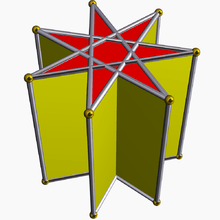 | 2 7/3 | 2 | 7/3.4.4 | D7h | C33d | -- | U78c | K03c | 14 | 21 | 9 | 2 | Yes | 3 | 7{4}+2{7/3} |
| Octagrammic prism | 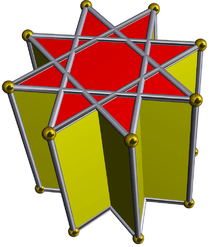 | 2 8/3 | 2 | 8/3.4.4 | D8h | C33e | -- | U78d | K03d | 16 | 24 | 10 | 2 | Yes | 3 | 8{4}+2{8/3} |
| Pentagrammic antiprism |  | | 2 2 5/2 |  5/2.3.3.3 | D5h | C34b | -- | U79a | K04a | 10 | 20 | 12 | 2 | Yes | 2 | 10{3}+2{5/2} |
| Pentagrammic crossed-antiprism |  | | 2 2 5/3 |  5/3.3.3.3 | D5d | C35a | -- | U80a | K05a | 10 | 20 | 12 | 2 | Yes | 3 | 10{3}+2{5/2} |
| Heptagrammic antiprism (7/2) |  | | 2 2 7/2 | 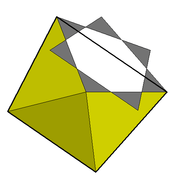 7/2.3.3.3 | D7h | C34d | -- | U79b | K04b | 14 | 28 | 16 | 2 | Yes | 3 | 14{3}+2{7/2} |
| Heptagrammic antiprism (7/3) |  | | 2 2 7/3 | 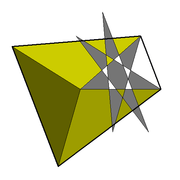 7/3.3.3.3 | D7d | C34d | -- | U79c | K04c | 14 | 28 | 16 | 2 | Yes | 3 | 14{3}+2{7/3} |
| Heptagrammic crossed-antiprism | 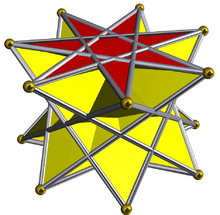 | | 2 2 7/4 |  7/4.3.3.3 | D7h | C35b | -- | U80b | K05b | 14 | 28 | 16 | 2 | Yes | 4 | 14{3}+2{7/3} |
| Octagrammic antiprism | 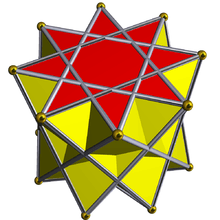 | | 2 2 8/3 |  8/3.3.3.3 | D8d | C34e | -- | U79d | K04d | 16 | 32 | 18 | 2 | Yes | 3 | 16{3}+2{8/3} |
| Octagrammic crossed-antiprism | 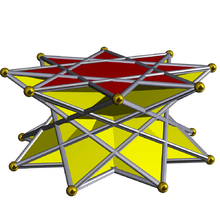 | | 2 2 8/5 |  8/5.3.3.3 | D8d | C35c | -- | U80c | K05c | 16 | 32 | 18 | 2 | Yes | 5 | 16{3}+2{8/3} |
| Small stellated dodecahedron |  | 5 | 2 5/2 | (5/2)5 | Ih | C43 | W020 | U34 | K39 | 12 | 30 | 12 | -6 | Yes | 3 | 12{5/2} |
| Great stellated dodecahedron | 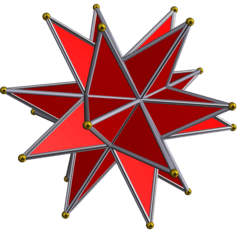 | 3 | 2 5/2 | 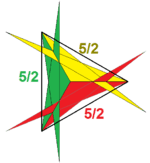 (5/2)3 | Ih | C68 | W022 | U52 | K57 | 20 | 30 | 12 | 2 | Yes | 7 | 12{5/2} |
| Ditrigonal dodeca- dodecahedron | 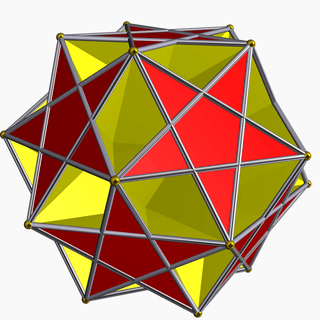 | 3 | 5/3 5 | (5/3.5)3 | Ih | C53 | W080 | U41 | K46 | 20 | 60 | 24 | -16 | Yes | 4 | 12{5}+12{5/2} |
| Small ditrigonal icosidodecahedron | 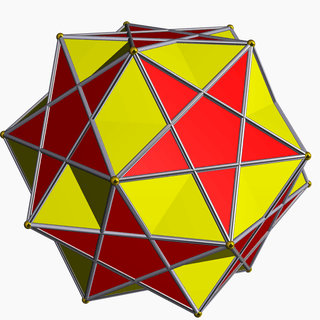 | 3 | 5/2 3 | (5/2.3)3 | Ih | C39 | W070 | U30 | K35 | 20 | 60 | 32 | -8 | Yes | 2 | 20{3}+12{5/2} |
| Stellated truncated hexahedron | 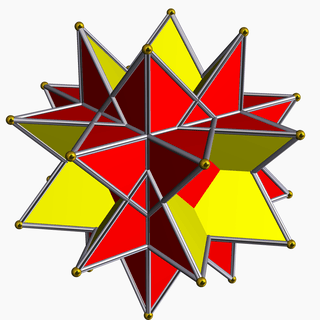 | 2 3 | 4/3 |  8/3.8/3.3 | Oh | C66 | W092 | U19 | K24 | 24 | 36 | 14 | 2 | Yes | 7 | 8{3}+6{8/3} |
| Great rhombihexahedron |  | 2 4/3 (3/2 4/2) | |  4.8/3.4/3.8/5 | Oh | C82 | W103 | U21 | K26 | 24 | 48 | 18 | -6 | No | 12{4}+6{8/3} | |
| Great cubicuboctahedron | 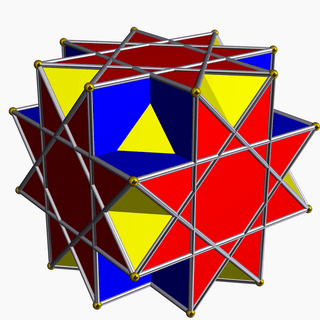 | 3 4 | 4/3 |  8/3.3.8/3.4 | Oh | C50 | W077 | U14 | K19 | 24 | 48 | 20 | -4 | Yes | 4 | 8{3}+6{4}+6{8/3} |
| Great dodecahemi- dodecahedron |  | 5/35/2 | 5/3 |  10/3.5/3.10/3.5/2 | Ih | C86 | W107 | U70 | K75 | 30 | 60 | 18 | -12 | No | 12{5/2}+6{10/3} | |
| Small dodecahemi- cosahedron |  | 5/35/2 | 3 | 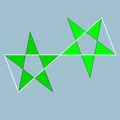 6.5/3.6.5/2 | Ih | C78 | W100 | U62 | K67 | 30 | 60 | 22 | -8 | No | 12{5/2}+10{6} | |
| Dodeca- dodecahedron |  | 2 | 5/2 5 | 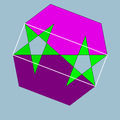 (5/2.5)2 | Ih | C45 | W073 | U36 | K41 | 30 | 60 | 24 | -6 | Yes | 3 | 12{5}+12{5/2} |
| Great icosihemi- dodecahedron |  | 3/2 3 | 5/3 |  10/3.3/2.10/3.3 | Ih | C85 | W106 | U71 | K76 | 30 | 60 | 26 | -4 | No | 20{3}+6{10/3} | |
| Great icosidodecahedron | 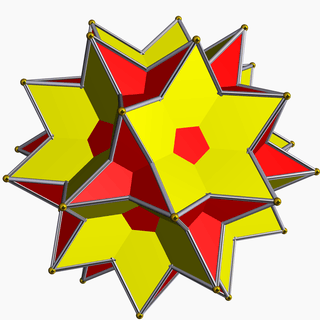 | 2 | 5/2 3 |  (5/2.3)2 | Ih | C70 | W094 | U54 | K59 | 30 | 60 | 32 | 2 | Yes | 7 | 20{3}+12{5/2} |
| Cubitruncated cuboctahedron |  | 4/3 3 4 | |  8/3.6.8 | Oh | C52 | W079 | U16 | K21 | 48 | 72 | 20 | -4 | Yes | 4 | 8{6}+6{8}+6{8/3} |
| Great truncated cuboctahedron |  | 4/3 2 3 | | 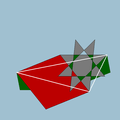 8/3.4.6/5 | Oh | C67 | W093 | U20 | K25 | 48 | 72 | 26 | 2 | Yes | 1 | 12{4}+8{6}+6{8/3} |
| Truncated great dodecahedron |  | 2 5/2 | 5 |  10.10.5/2 | Ih | C47 | W075 | U37 | K42 | 60 | 90 | 24 | -6 | Yes | 3 | 12{5/2}+12{10} |
| Small stellated truncated dodecahedron | 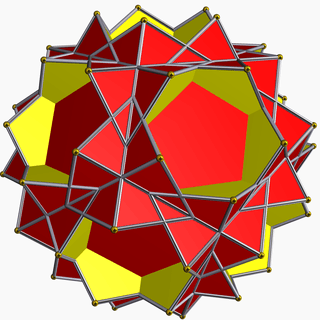 | 2 5 | 5/3 | 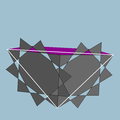 10/3.10/3.5 | Ih | C74 | W097 | U58 | K63 | 60 | 90 | 24 | -6 | Yes | 9 | 12{5}+12{10/3} |
| Great stellated truncated dodecahedron | 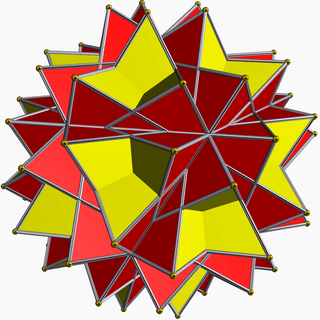 | 2 3 | 5/3 |  10/3.10/3.3 | Ih | C83 | W104 | U66 | K71 | 60 | 90 | 32 | 2 | Yes | 13 | 20{3}+12{10/3} |
| Truncated great icosahedron | 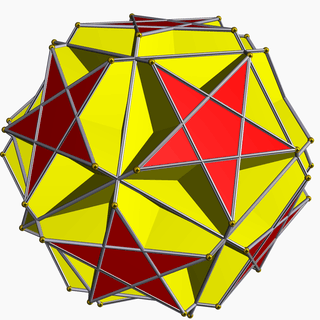 | 2 5/2 | 3 | 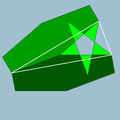 6.6.5/2 | Ih | C71 | W095 | U55 | K60 | 60 | 90 | 32 | 2 | Yes | 7 | 12{5/2}+20{6} |
| Great dodecicosahedron | 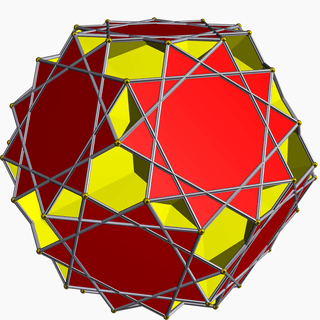 | 3 5/3(3/2 5/2) | | 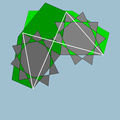 6.10/3.6/5.10/7 | Ih | C79 | W101 | U63 | K68 | 60 | 120 | 32 | -28 | No | 20{6}+12{10/3} | |
| Great rhombidodecahedron | 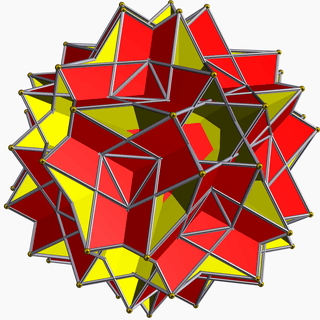 | 2 5/3 (3/2 5/4) | |  4.10/3.4/3.10/7 | Ih | C89 | W109 | U73 | K78 | 60 | 120 | 42 | -18 | No | 30{4}+12{10/3} | |
| Icosidodeca- dodecahedron |  | 5/3 5 | 3 |  6.5/3.6.5 | Ih | C56 | W083 | U44 | K49 | 60 | 120 | 44 | -16 | Yes | 4 | 12{5}+12{5/2}+20{6} |
| Small ditrigonal dodecicosi- dodecahedron | 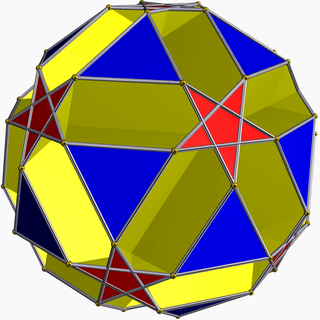 | 5/3 3 | 5 |  10.5/3.10.3 | Ih | C55 | W082 | U43 | K48 | 60 | 120 | 44 | -16 | Yes | 4 | 20{3}+12{5/2}+12{10} |
| Great ditrigonal dodecicosi- dodecahedron |  | 3 5 | 5/3 | 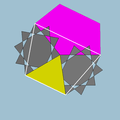 10/3.3.10/3.5 | Ih | C54 | W081 | U42 | K47 | 60 | 120 | 44 | -16 | Yes | 4 | 20{3}+12{5}+12{10/3} |
| Great dodecicosi- dodecahedron | 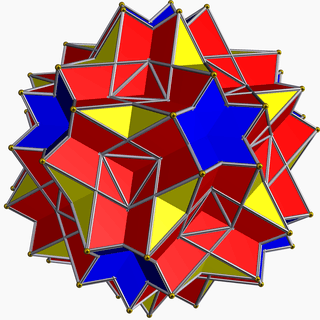 | 5/2 3 | 5/3 | 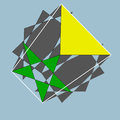 10/3.5/2.10/3.3 | Ih | C77 | W099 | U61 | K66 | 60 | 120 | 44 | -16 | Yes | 10 | 20{3}+12{5/2}+12{10/3} |
| Small icosicosi- dodecahedron | 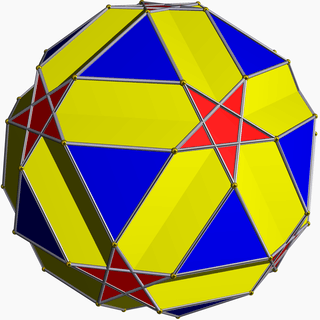 | 5/2 3 | 3 |  6.5/2.6.3 | Ih | C40 | W071 | U31 | K36 | 60 | 120 | 52 | -8 | Yes | 2 | 20{3}+12{5/2}+20{6} |
| Rhombidodeca- dodecahedron |  | 5/2 5 | 2 | 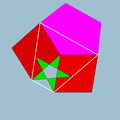 4.5/2.4.5 | Ih | C48 | W076 | U38 | K43 | 60 | 120 | 54 | -6 | Yes | 3 | 30{4}+12{5}+12{5/2} |
| Great rhombicosi- dodecahedron | 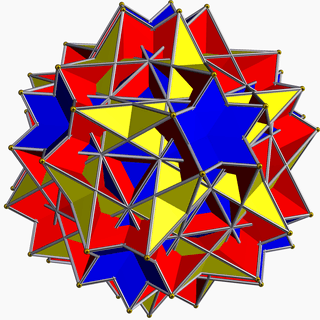 | 5/3 3 | 2 |  4.5/3.4.3 | Ih | C84 | W105 | U67 | K72 | 60 | 120 | 62 | 2 | Yes | 13 | 20{3}+30{4}+12{5/2} |
| Icositruncated dodeca- dodecahedron |  | 5/3 3 5 | | 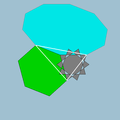 10/3.6.10 | Ih | C57 | W084 | U45 | K50 | 120 | 180 | 44 | -16 | Yes | 4 | 20{6}+12{10}+12{10/3} |
| Truncated dodeca- dodecahedron | 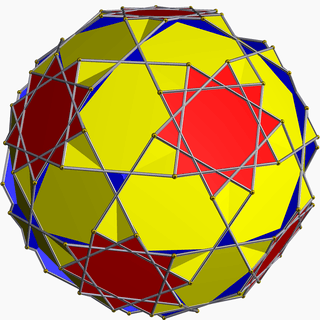 | 5/3 2 5 | |  10/3.4.10/9 | Ih | C75 | W098 | U59 | K64 | 120 | 180 | 54 | -6 | Yes | 3 | 30{4}+12{10}+12{10/3} |
| Great truncated icosidodecahedron |  | 5/3 2 3 | |  10/3.4.6 | Ih | C87 | W108 | U68 | K73 | 120 | 180 | 62 | 2 | Yes | 13 | 30{4}+20{6}+12{10/3} |
| Snub dodeca- dodecahedron |  | | 2 5/2 5 |  3.3.5/2.3.5 | I | C49 | W111 | U40 | K45 | 60 | 150 | 84 | -6 | Yes | 3 | 60{3}+12{5}+12{5/2} |
| Inverted snub dodeca- dodecahedron | 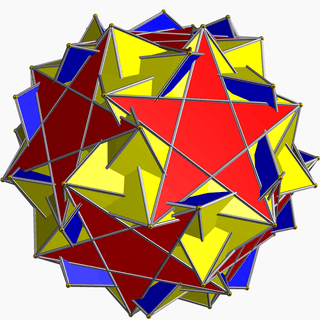 | | 5/3 2 5 |  3.5/3.3.3.5 | I | C76 | W114 | U60 | K65 | 60 | 150 | 84 | -6 | Yes | 9 | 60{3}+12{5}+12{5/2} |
| Great snub icosidodecahedron |  | | 2 5/2 3 | 34.5/2 | I | C73 | W113 | U57 | K62 | 60 | 150 | 92 | 2 | Yes | 7 | (20+60){3}+12{5/2} |
| Great inverted snub icosidodecahedron | 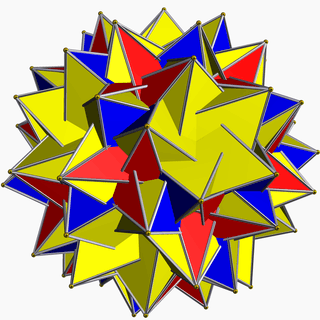 | | 5/3 2 3 | 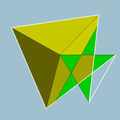 34.5/3 | I | C88 | W116 | U69 | K74 | 60 | 150 | 92 | 2 | Yes | 13 | (20+60){3}+12{5/2} |
| Great retrosnub icosidodecahedron | 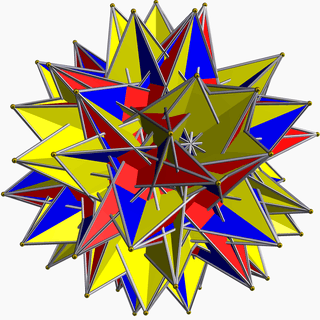 | | 3/25/3 2 | 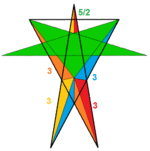 (34.5/2)/2 | I | C90 | W117 | U74 | K79 | 60 | 150 | 92 | 2 | Yes | 37 | (20+60){3}+12{5/2} |
| Great snub dodecicosi- dodecahedron | 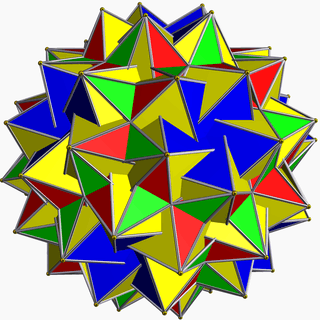 | | 5/35/2 3 |  33.5/3.3.5/2 | I | C80 | W115 | U64 | K69 | 60 | 180 | 104 | -16 | Yes | 10 | (20+60){3}+(12+12){5/2} |
| Snub icosidodeca- dodecahedron | 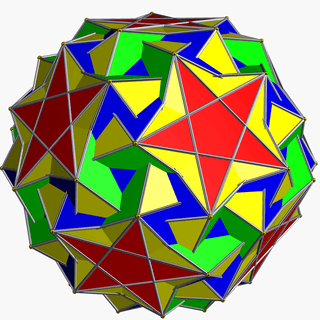 | | 5/3 3 5 | 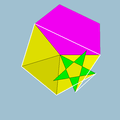 33.5.5/3 | I | C58 | W112 | U46 | K51 | 60 | 180 | 104 | -16 | Yes | 4 | (20+60){3}+12{5}+12{5/2} |
| Small snub icos- icosidodecahedron |  | | 5/2 3 3 | 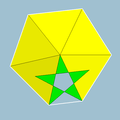 35.5/2 | Ih | C41 | W110 | U32 | K37 | 60 | 180 | 112 | -8 | Yes | 2 | (40+60){3}+12{5/2} |
| Small retrosnub icosicosi- dodecahedron | 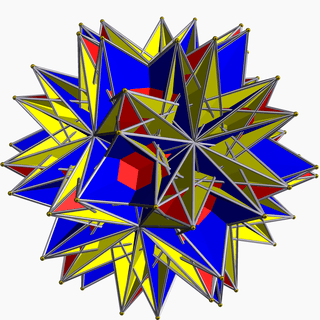 | | 3/23/25/2 | 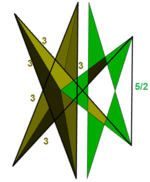 (35.5/3)/2 | Ih | C91 | W118 | U72 | K77 | 60 | 180 | 112 | -8 | Yes | 38 | (40+60){3}+12{5/2} |
| Great dirhombicosi- dodecahedron |  | | 3/25/3 3 5/2 | 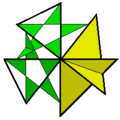 (4.5/3.4.3. 4.5/2.4.3/2)/2 | Ih | C92 | W119 | U75 | K80 | 60 | 240 | 124 | -56 | No | 40{3}+60{4}+24{5/2} |
| Name | Image | Wyth sym | Vert. fig | Sym. | C# | W# | U# | K# | Vert. | Edges | Faces | Chi | Orient able? | Dens. | Faces by type |
|---|---|---|---|---|---|---|---|---|---|---|---|---|---|---|---|
| Great disnub dirhombidodecahedron* | 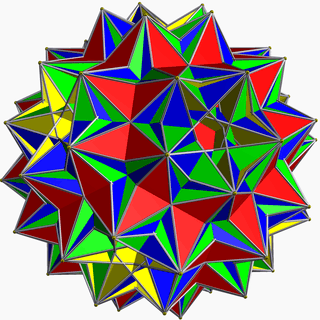 | | (3/2) 5/3 (3) 5/2 | 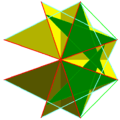 (5/2.4.3.3.3.4. 5/3. 4.3/2.3/2.3/2.4)/2 | Ih | -- | -- | -- | -- | 60 | 360 (*) | 204 | -96 | No | 120{3}+60{4}+24{5/2} |
(*) : The great disnub dirhombidodecahedron has 240 of its 360 edges coinciding in space 120 pairs. Because of this edge-degeneracy, it is not always considered to be a uniform polyhedron.
Column key
- Uniform indexing: U01-U80 (Tetrahedron first, Prisms at 76+)
- Kaleido software indexing: K01-K80 (Kn = Un-5 for n = 6 to 80) (prisms 1-5, Tetrahedron etc. 6+)
- Magnus Wenninger Polyhedron Models: W001-W119
- 1-18 - 5 convex regular and 13 convex semiregular
- 20-22, 41 - 4 non-convex regular
- 19-66 Special 48 stellations/compounds (Nonregulars not given on this list)
- 67-109 - 43 non-convex non-snub uniform
- 110-119 - 10 non-convex snub uniform
- Chi: the Euler characteristic, χ. Uniform tilings on the plane correspond to a torus topology, with Euler characteristic of zero.
- Density: the Density (polytope) represents the number of windings of a polyhedron around its center. This is left blank for non-orientable polyhedra and hemipolyhedra (polyhedra with faces passing through their centers), for which the density is not well-defined.
- Note on Vertex figure images:
- The white polygon lines represent the "vertex figure" polygon. The colored faces are included on the vertex figure images help see their relations. Some of the intersecting faces are drawn visually incorrectly because they are not properly intersected visually to show which portions are in front.
See also
References
- Coxeter, Harold Scott MacDonald; Longuet-Higgins, M. S.; Miller, J. C. P. (1954). "Uniform polyhedra". Philosophical Transactions of the Royal Society of London. Series A. Mathematical and Physical Sciences. The Royal Society. 246 (916): 401–450. Bibcode:1954RSPTA.246..401C. doi:10.1098/rsta.1954.0003. ISSN 0080-4614. JSTOR 91532. MR 0062446.CS1 maint: ref=harv (link)
- Skilling, J. (1975). "The complete set of uniform polyhedra". Philosophical Transactions of the Royal Society of London. Series A. Mathematical and Physical Sciences. 278 (1278): 111–135. Bibcode:1975RSPTA.278..111S. doi:10.1098/rsta.1975.0022. ISSN 0080-4614. JSTOR 74475. MR 0365333.CS1 maint: ref=harv (link)
- Sopov, S. P. (1970). "A proof of the completeness on the list of elementary homogeneous polyhedra". Ukrainskiui Geometricheskiui Sbornik (8): 139–156. MR 0326550.CS1 maint: ref=harv (link)
- Wenninger, Magnus (1974). Polyhedron Models. Cambridge University Press. ISBN 0-521-09859-9.
- Wenninger, Magnus (1983). Dual Models. Cambridge University Press. ISBN 0-521-54325-8.
External links
- Stella: Polyhedron Navigator - Software able to generate and print nets for all uniform polyhedra. Used to create most images on this page.
- Paper models
- Uniform indexing: U1-U80, (Tetrahedron first)
- Uniform Polyhedra (80), Paul Bourke
- Weisstein, Eric W. "Uniform Polyhedron". MathWorld.
- http://www.mathconsult.ch/showroom/unipoly
- https://web.archive.org/web/20171110075259/http://gratrix.net/polyhedra/uniform/summary/
- http://www.it-c.dk/edu/documentation/mathworks/math/math/u/u034.htm
- http://www.buddenbooks.com/jb/uniform/
- Kaleido Indexing: K1-K80 (Pentagonal prism first)
- Also